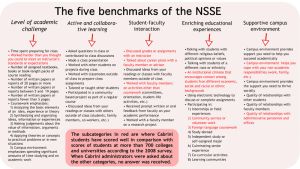“Value-added” education aims to improve students’ education outside the classroom
Colleges, including Cabrini, create slogans to highlight the unique education that they believe they offer. “Do Something Extraordinary” and “Justice Matters” are just two of Cabrini’s claims.
In the higher education field, these aspects beyond the delivery of courses are known as the “value-added” portion of the college experience.
These claims refer to how much a student has gained, achieved or been enhanced by educational experiences. The areas that may be enhanced include knowledge, skills and abilities.
“At Cabrini we have significant ‘value added’ elements that help distinguish us from all other institutions—chief among them, our very unique Justice Matters Curriculum, which is rooted in Catholic Social Teaching and our Cabrinian heritage,” Dr. Anne Skleder, provost and vice president of academic affairs, said.
“It informs what is taught in the classroom and transformative experiences students have outside the classroom—for example our partnerships in Norristown and in Swaziland—and they then take into their careers and their lives after graduation,” Skleder said.
According to Skleder, institutions may be evaluated or assessed on the basis of the cumulative value that they add to their students and some argue that the status of an institution should be judged by their “value-added” contribution. Of course, “value-added” is difficult to calculate.
“Right now we are working on measuring our impact on students’ understanding of social justice,” Skleder said. “There are no measures, and through work with a national group called The Wabash Study, Dr. Gingerich and the faculty are developing a way to measure this that other schools may use in the future.”
According to the Wabash Study webpage, the study is a three-year project designed to create a deliberative process for using evidence that an institution can build on for improvements in student learning. There are currently 30 colleges and universities participating in the 2010 study.
Institutions use the study to measure a certain aspect of their education. David Glenn wrote in The Chronicle of Higher Education that some institutions are using the study to measure the effects of their senior capstone courses, effectiveness of student help centers on campus and student research and writing skills.
The National Survey of Student Advancement (NSSE) is another way that colleges and universities collect data about student advancement through a variety of categories known as “benchmarks.”

NSSE is administered to students on the freshman and senior level. There are five benchmarks in total composed of 41 subcategories. Cabrini students have scored well in comparison with scores of students at more than 700 colleges and universities in several categories, according to the 2008 survey.
“While most popular college rankings are based primarily on measures of resources and reputation that research studies indicate are not related to learning and personal development outcomes, NSSE results are determined by the students and not by external organizations rating or assessing colleges and universities,” Lisa Plummer, Director of Institutional Effectiveness, said.
After the college receives the results from a survey such as the NSSE, one may wonder what is done with the results.
According to Media Relations Manager Dan DiPrinzio, the college includes results when applicable from surveys in publications as well as in press releases and posted on the college website.
“Once results have been interpreted, the Office of Institutional Effectiveness presents the findings to campus leadership and faculty for meaningful discussion,” Plummer said. “Cabrini employs multiple means of assessment (i.e. surveys, focus groups, etc.,) both for improvement and accountability. It is from these multiple means that campus decisions are made and improvements occur.”
According to Plummer, one change that has occurred as a result of multiple assessments, focus groups and campus polls was the revamping of Rooymans Hall as a student center.
See the graphic above to see what categories Cabrini students have been recorded to have done well according to an email sent by Plummer. However, the actual data is not available for Loquitur to examine.


